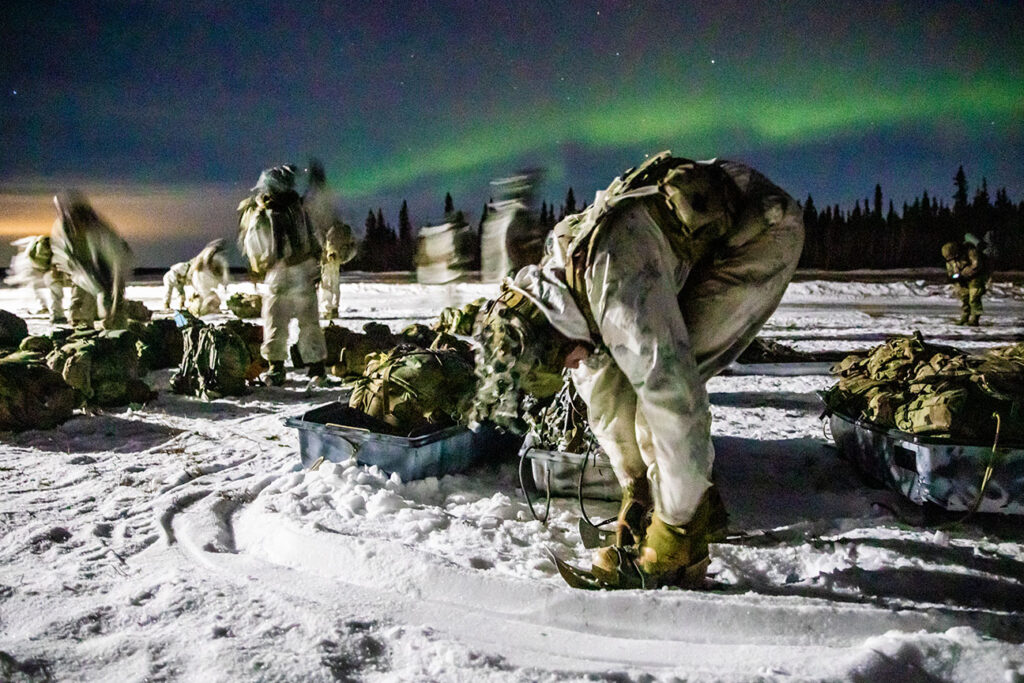A U.S. Soldier, attached to 1st Battalion, 5th Infantry Regiment, wears snowshoes during Joint Pacific Multinational Readiness Center 24-02 at Donnelly training area, Alaska. The Soldiers used the cold weather gear move along the wood line for 1 kilometer. PFC. ELIJAH MAGAÑA/U.S. ARMY
THE WATCH STAFF
For the first time in more than 50 years, the U.S. Army has released a manual that will serve as a blueprint for Soldiers and Marines operating in the Arctic and extreme cold. The 267-page Army Techniques Publication (ATP) 3-90.96: Arctic and Extreme Cold Weather Operations was published in February.
The new document comes as sea ice melts in the Arctic, opening sea lanes and shifting geopolitics. “You’ve got the Russians, the Chinese and other people moving around up there, looking for resources or looking for ways to flow goods and exploit that area economically or so forth,” Richard Creed, director of the Combined Arms Doctrine Directorate at Fort Leavenworth, Kansas, told Task & Purpose, an online publication.
The manual focuses on the details of combat, such as ambushes and evacuations, in the world’s coldest conditions, emphasizing that fighting in bitter cold is a “perishable skill” that the Army hasn’t stressed until recently, Creed said. It also covers cold weather training, survival skills, equipment maintenance, medical treatment and mobility.
The manual also touches on more obscure issues, like advising chaplains that “Chalices and cups may freeze to the mouth or hands. Water and sacramental wine may freeze in these objects if they are not already frozen before pouring.”
There’s a similar warning for Army bands, especially members who play metal instruments: “During freezing temperatures, bands [should] limit conducting performances to heated areas to avoid performance issues, damage to instruments, or bodily injury.”
But the manual’s primary focus is on survival. “Almost everything else about your baseline assumptions of how the environment operates changes,” Army Capt. Ed Garibay, lead author of the manual, told Task & Purpose. “The fundamental understanding that the sun will come up tomorrow is not a given fact in the Arctic. If you’re in the winter time frame, you have periods of 24 hours of darkness or longer.”
In an online article for the Association of the United States Army, Garibay says “the new doctrine helps soldiers understand three things: What are Arctic operations, why are they important, and how can soldiers meet the challenges of an Arctic environment?”
The manual details the unforgiving nature of extreme cold and prolonged periods of darkness and what they mean for U.S. Soldiers: slower movement, cold weather injuries and the need to keep morale up to help troops avoid depression and “cocooning,” which is “withdrawn behavior resulting from inexperience to the cold.”
In his online article, Garibay says the manual does not attempt to define “Arctic” but instead organizes its definitions into three categories: latitude, climate and terrain. “Each category has important tactical significance for the warfighter:
- Latitude can create up to 24 hours of daylight or darkness, as well as significantly disrupt communications because of solar storms.
- The climate can push temperatures down to minus 40 degrees and, in some regions, down to minus 60 degrees.
- Arctic terrain reduces mobility and requires a tactical shift when Soldiers move from ice cap to tundra to boreal forest.”
Garibay points out that summer Arctic operations can sometimes be even more time-consuming and frustrating than winter missions “because of widespread bogs (known as muskeg) that limit vehicle movement.”
“There’s a saying in the high north: ‘Everything takes longer in the Arctic.’ Bulky clothes, snow and muskeg complicate things,” Garibay said in his online article. “Distances that normally would take an infantry platoon 30 minutes to traverse could take up to four hours or more.”
While cold weather adaptability is essential to survival, mobility is essential to accomplish the mission, Garibay says. “Without people and equipment adapted to the cold, armies often suffer more casualties to the weather than to the enemy. Without mobility, units struggle to accomplish their objective and sustain themselves.”
The manual advocates for “arctic determination,” which is derived from the Finnish word “sisu,” meaning grit or perseverance and “ability to maintain your composure in very extreme conditions,” Garibay told Task & Purpose.
“It’s not a coincidence that the Finns, who live in extreme Arctic conditions, have a word for this,” he said. “It’s not the quintessential cliche of ‘embrace the suck.’ … It’s not blind ambition into unsafe situations. It’s a building of confidence in your ability to overcome the environment so that you can succeed and thrive in this environment.”
As the manual says, “Arctic determination is an individual’s mental and physical tenacity to accomplish the mission by leveraging confidence in personal skills to overcome extreme cold weather and other arctic challenges. Soldiers and Marines with arctic determination … understand that the Arctic is challenging, and they are willing to meet those challenges. Ultimately, arctic determination is the will to get the job done despite arctic challenges.”

